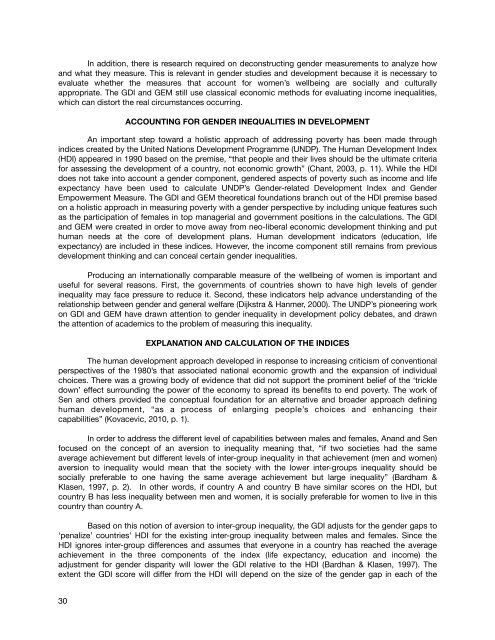Undercurrent-Issue-Fall-Winter-2014-3
Undercurrent-Issue-Fall-Winter-2014-3
Undercurrent-Issue-Fall-Winter-2014-3
You also want an ePaper? Increase the reach of your titles
YUMPU automatically turns print PDFs into web optimized ePapers that Google loves.
In addition, there is research required on deconstructing gender measurements to analyze howand what they measure. This is relevant in gender studies and development because it is necessary toevaluate whether the measures that account for women’s wellbeing are socially and culturallyappropriate. The GDI and GEM still use classical economic methods for evaluating income inequalities,which can distort the real circumstances occurring.ACCOUNTING FOR GENDER INEQUALITIES IN DEVELOPMENT" An important step toward a holistic approach of addressing poverty has been made throughindices created by the United Nations Development Programme (UNDP). The Human Development Index(HDI) appeared in 1990 based on the premise, “that people and their lives should be the ultimate criteriafor assessing the development of a country, not economic growth” (Chant, 2003, p. 11). While the HDIdoes not take into account a gender component, gendered aspects of poverty such as income and lifeexpectancy have been used to calculate UNDP’s Gender-related Development Index and GenderEmpowerment Measure. The GDI and GEM theoretical foundations branch out of the HDI premise basedon a holistic approach in measuring poverty with a gender perspective by including unique features suchas the participation of females in top managerial and government positions in the calculations. The GDIand GEM were created in order to move away from neo-liberal economic development thinking and puthuman needs at the core of development plans. Human development indicators (education, lifeexpectancy) are included in these indices. However, the income component still remains from previousdevelopment thinking and can conceal certain gender inequalities." Producing an internationally comparable measure of the wellbeing of women is important anduseful for several reasons. First, the governments of countries shown to have high levels of genderinequality may face pressure to reduce it. Second, these indicators help advance understanding of therelationship between gender and general welfare (Dijkstra & Hanmer, 2000). The UNDP’s pioneering workon GDI and GEM have drawn attention to gender inequality in development policy debates, and drawnthe attention of academics to the problem of measuring this inequality.EXPLANATION AND CALCULATION OF THE INDICES" The human development approach developed in response to increasing criticism of conventionalperspectives of the 1980’s that associated national economic growth and the expansion of individualchoices. There was a growing body of evidence that did not support the prominent belief of the ‘trickledown’ effect surrounding the power of the economy to spread its benefits to end poverty. The work ofSen and others provided the conceptual foundation for an alternative and broader approach defininghuman development, “as a process of enlarging people’s choices and enhancing theircapabilities” (Kovacevic, 2010, p. 1)." In order to address the different level of capabilities between males and females, Anand and Senfocused on the concept of an aversion to inequality meaning that, “if two societies had the sameaverage achievement but different levels of inter-group inequality in that achievement (men and women)aversion to inequality would mean that the society with the lower inter-groups inequality should besocially preferable to one having the same average achievement but large inequality” (Bardham &Klasen, 1997, p. 2). In other words, if country A and country B have similar scores on the HDI, butcountry B has less inequality between men and women, it is socially preferable for women to live in thiscountry than country A." Based on this notion of aversion to inter-group inequality, the GDI adjusts for the gender gaps to‘penalize’ countries’ HDI for the existing inter-group inequality between males and females. Since theHDI ignores inter-group differences and assumes that everyone in a country has reached the averageachievement in the three components of the index (life expectancy, education and income) theadjustment for gender disparity will lower the GDI relative to the HDI (Bardhan & Klasen, 1997). Theextent the GDI score will differ from the HDI will depend on the size of the gender gap in each of the30


